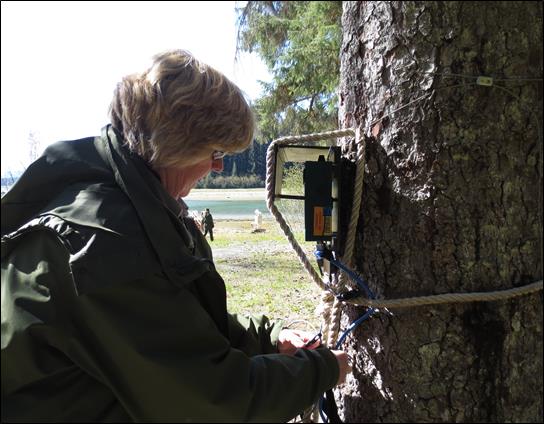What bat species occur within Glacier Bay National Park and Preserve? When are they active, both daily and seasonally?
Project Dates
Automated data collection February 2012 - December 2013; data analysis/reporting by July 2014.
Did You Know?
Different species of bats echolocate with specific sound frequencies that suit their habitat and prey types. The calls of some species are easy to recognize; others are less distinct. Ultrasonic bat detectors may be able to identify individual species by their calls.
Introduction

The little brown bat (or little brown myotis) is the most abundant and widely distributed bat in Alaska. In Southeast Alaska, four other species have been documented (Keen’s myotis, California myotis, long-legged myotis, and silver-haired bat), but their
distributions within the region are not well known. It was not until 2005 that Keen’s and California myotis were first captured in Juneau; those observations extended their known range northward by 300 km. Large areas of Southeast Alaska remain completely unsurveyed. No estimates of population size, trend or relative abundance are available for bats anywhere in Alaska. Similarly, almost nothing is known about their migration patterns, overwintering strategies, or winter roost preferences.
A bat monitoring program was begun in Juneau in 2010 and expanded in 2011 and 2012 to include seven other locations from Ketchican to Yakutat, including Bartlett Cove in Glacier Bay National Park and Preserve. The primary tool used is a “bat
detector”- a recording device used to detect the presence of bats by converting their echolocation ultrasound signals to frequencies audible to humans.
In addition to establishing a baseline for bat activity across the region, researchers hope to better document the seasonal distribution of bats within Southeast Alaska. The daily timing of activity and presence/absence of activity in winter can provide insights on whether bats are overwintering locally or migrating to spend the winter elsewhere. Comparing seasonal activity patterns across the region may help identify migration routes.
The research may also help establish baseline levels of bat activity prior to the arrival of White-Nose Syndrome, a fungal disease that has killed an estimated six million bats in eastern North America since 2006. White-Nose Syndrome may not be a serious threat in the Pacific Northwest and Alaska, since bats do not roost in huge concentrations here.
Methods
Researchers installed a bat detector in Bartlett Cove near the park headquarters building in February 2012. The AC-powered detector is mounted under a rainguard attached to a tree 1.4 m above the ground. The detector is programmed to collect data from sunset to sunrise year-round. A sensor records temperature and relative humidity at hourly intervals. The detector is checked every 3-4 weeks to ensure the equipment is working properly and to replace the back-up battery and memory cards.
In 2013, an additional detector will be installed along the Alsek River in Glacier Bay National Preserve at Dry Bay. This detector will be operational only for the summer season.
Findings

Detector recordings in 2012 indicated that average nightly activity was lowest in May and highest in July and September. The high September average was driven by a four-day peak in activity late in the month that may have been associated with migration or fall mating activity. Due to equipment problems, the detector failed to record the timing of cessation of activity in the fall of 2012 or the emergence (or arrival) of bats in the spring of 2013, but additional 2013 data should fill those gaps.
Myotis bats (difficult to distinguish individual species) were the most common species detected. Silver-haired bats (Lasionycteris noctivagans) were probably also recorded - to be confirmed by further analysis.
Bats are present in Bartlett Cove year-round and are occasionally active in the winter. They roost in buildings, under the bark of large trees, and in rock crevices. Their presence in the administration building at park headquarters became a sanitation concern by summer 2013. Bat abatement efforts were initiated, including the installation of exclusion devices that allow bats to exit the building but not re-enter. It will be interesting to see what effect this has on the number of bats detected.
Last updated: September 13, 2016
